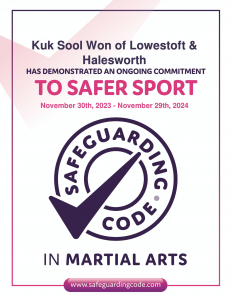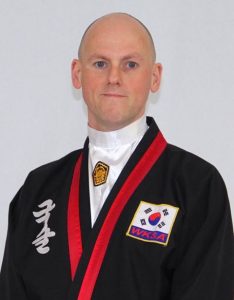OUR SAFEGUARDING OFFICES
Lowestoft – Jonathan Denny TEL 07716529455
 Halesworth – Charlotta Trimby TEL 07483321096
Halesworth – Charlotta Trimby TEL 07483321096
Safeguarding in the Martial Arts: Safe Practice
Martial Arts are activities where safe practice is essential to help prevent injury. *Children are particularly vulnerable as they are still developing mentally and physically, so training methods need to be modified as described below. (*also includes Adults at Risk)
1. Warm Ups
All activities should first include a thorough warm up, and head to toe stretching and gradual cardiovascular activity. To help reduce injury, specific attention should be paid to those muscle groups that will be used during later activity.
2. Martial Arts involving throwing, grappling and strangling
The risks include: falling on unsuitable surfaces: landing on the head: damage to the joints from locks: strangulation.
Safe practice must include:
- (a) Checking the matted area for suitability, particularly where the mats have been joined.
- (b) Checking that there are no hard surfaces or sharp/hard objects around the matted area.
- (c) Having an experience instructor who will ensure that children are not taught to use locks, throws or strangles which will injure their training partner.
3. Martial Arts involving strikes, punches and kicks
The risks are: concussion (brain injury) from heavy blows to the head; damage to internal organs and joints from heavy blows; injury from inappropriate stretching and other exercises.
Safe practice must include:
4.
Martial Arts involving weapons
(a)
Light contact only, especially to the head. (Light contact means the technique is targeted but controlled so that whilst the opponent is touched the technique is not followed through). Expert advice from a neurosurgeon is that the use of helmets, mitts or foot pads does not eliminate the risk of brain injury from full contact strikes.
Avoiding excessive stretching and exercises such as press-ups on the knuckles or hitting heavy bags; the joints of children are still developing and can be damaged by these exercise
(b)
Safe practice must include:
(a) No live blades (sharp or otherwise) in the training hall when children are present
(b) Safe protocols for the use of training weapons by children
(c) Good supervision at all times by Instructors.
Martial arts can result in a wide array of injuries. The injury type is often dependent on the particular form of martial art being performed. Many forms of martial arts are actually non-contact and these tend to result in overuse injuries. Contact martial arts vary widely in their techniques, rules, and protective equipment and these factors affect the injuries and injury rates.
Concussion
Common symptoms of concussion include headache, dizziness, nausea, balance problems, difficulties with concentration, and memory problems. Symptoms can last from several minutes to days, weeks, months, or even longer in some cases. Martial arts that emphasise striking and throwing are more likely to result in concussions. Any athlete with symptoms of concussion should be removed from play and evaluated by a health professional. They should not be allowed to return to play until cleared by a qualified health care professional.
Head/Eyes/Ear/Nose
Striking and grappling can result in minor injuries such as cuts, bruises and lacerations. More serious injuries, such as fractures of the nose, face, or skull as well as significant injuries of the eyes mouth or teeth can result. These injuries may be minimised by selection of martial arts style, proper training and coaching, and use of protective equipment.
Neck
Minor injuries to the neck, such as bruising and abrasions, are most common. However, some forms of martial arts, such as jujitsu, judo, and mixed martial arts, do allow choking techniques that can result in loss of consciousness. It’s important to understand the risks of different forms of martial arts and to learn them under appropriate supervision.
Extremities
Injuries to the extremities include cuts, bruises, sprains, and strains. Fractures and joint dislocations are less common, but can occur, particularly in styles that use throws and joint locking techniques. Injuries can be minimised with proper supervision and the use of appropriate technique.
Skin
Cuts are fairly common injuries in martial arts. Athletes participating in contact sports, such as wrestling and martial arts, can be more prone to developing certain skin infections. These injuries should be evaluated and treated by an appropriate health care professional.
SAFE PRACTICE SUMMARY
Above all, safe practice means having a suitably qualified and experienced instructor who will ensure that children and adults are not exposed to the above risks and who can make a training session enjoyable whilst maintaining the discipline essential to learning a Martial Art.







